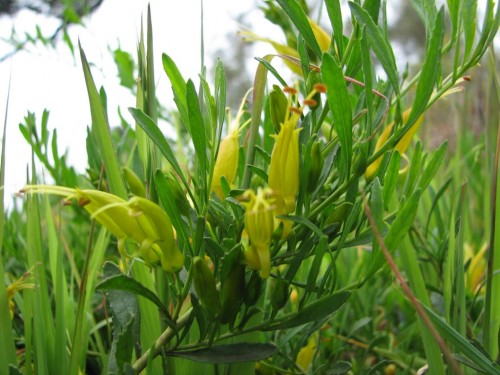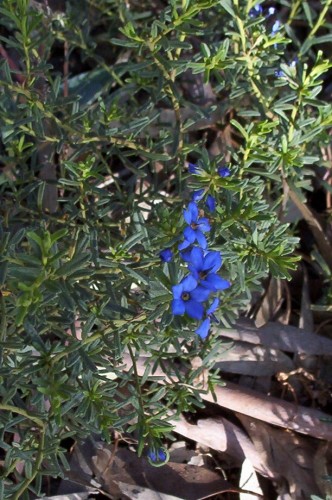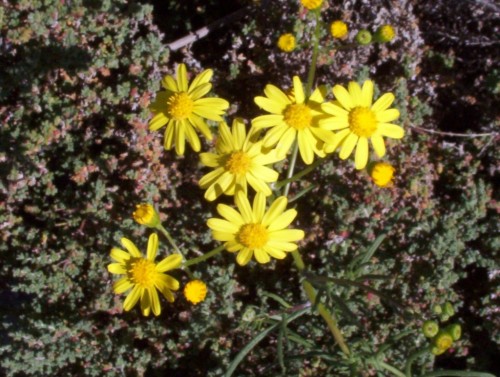Hardy Ground Covering Plants
I was checking on the garden forum and came across a request for help re growing some Western Australian plants in Newcastle, north of Sydney. The person writing had done his homework and was prepared to create a good mound to provide extra drainage for the plants he wanted to try in the ground. I would have thought he would have had success with what he proposed to do. However someone said that he had not taken into account the humidity of the area. This is something that had not crossed my mind at all.
Here humidity is associated with thunderstorms and changes in weather patterns in the summer. Basically the climate is dry. What I call hardy plants could well turn out to be difficult plants in a humid climate. It certainly pays to think about atmosphere as well as soil conditions and moisture in the overall picture of growing plants. Some plants will adapt when they are grown in the open with good air flow around them, rather that being part of dense undergrowth. Otherwise they are subject to fungal attacks.
I decided to actually make a few lists of plants and then find information about the plants, rather than find then one by one.
Hardy Ground Covering Plants
Brachyscome multifida ‘Amethyst’ (Cut leaf Daisy)
Brachyscome multifida ‘Breako’day’ (Cut Leaf Daisy)
Leucophyta brownii (Cushion Bush)
Calothamnus quadrifidus prostrate form
Chrysocephalum apiculatum (Yellow Buttons)
Correa alba low forms (White Correa)
Correa decumbens (Mt Lofty Correa)
Correa ‘Dusky Bells’
Dampiera diversifolia
Eremophila glabra prostrate, yellow flowers (Emu Bush)
Goodenia varia (Sticky Goodenia)
Grevillea lanigera (Woolly Grevillea)
Grevillea thelemanniana ‘Sea Foam’
Grevillea thelemanniana prostrate forms
Halgania cyanea (Mallee Blue-Bush)
Myoporum parvifolium (Creeping Myoporum)
Rhagodia spinescens (Hedge Saltbush)
Scaevola aemula (Fan Flower)
Scaevola ‘Mauve Clusters’ (Fan Flower)
Related Articles
- Twenty Drought Tolerant Plants here.
- Frost Hardy Plants here.
- Hardy Eremophilas here
Eremophila glabra prostrate, yellow form (Hardy Plant 2)
This prostrate from of Eremophila glabra is particularly hardy. It seems to grow in most soil types, is very drought tolerant and also lime and frost tolerant. The nectar feeding birds appreciate the fact that it flowers for most of the year.
The occasional branch may reach to 30cm tall but it is mostly up to about 20cm tall by up to two metres wide. A spade makes a good pruning tool to stop it wandering where it is not wanted. Given reasonable drainage, it appears to last many years. In cooler, moister areas the glabra forms of Eremophila need to be planted in the open.
Any method of providing a raised bed improves the drainage for Australian native plants. To shift some soil from one spot to create a small water catchment near the root zone of a plant provides a mound with some extra height to improve drainage for another plant. I have read that as little as 10cm extra height in the soil in the planting spot will vastly improve conditions for plants that must have good drainage.
Halgania cyanea (Mallee Blue-flower) (Hardy Plant 1)
This deep blue flowering plant gives a stunning display during the summer. The flower is actually blue. This is a suckering plant often seen on the road sides around here where it has escaped the grader blades. It creeps underground and sends up clumping suckers a little way from the parent plant. Harsh cutting to rejuvenate the plant will result in suckering.
This plant is widespread in Australia, in fact everywhere except Tasmania. It does not like extended periods of humidity and needs to be grown in the open in cool climate regions. It is suited to semi-arid and temperate regions. They need reasonable drainage and do appreciate some extra water in our area of 340mm (13.25inches) rain. This plant is hardy to moderately heavy frosts and extended dry periods.
I find this extremely difficult to photograph because of the intense blue of the flowers.
Hardy Australian Native Plants
My sister gave me a beautiful Azalea last weekend to cheer me up after a stay in hospital. She picked it out on the basis of the word ‘hardy’ on the plant label. It appears that this one will take full sun. I have a question mark in my mind about that when I consider temperatures of 103C in mid January for two weeks at a time which is quite possible here. However with some extra shade at that time of the year I am quite hopeful. It also says ‘will not tolerate lime’ so this plant is destined to be pot grown forever. It would be too much to ask that lime intolerance be bred out of a species.
I certainly appreciate a flowering plant in a pot which will give me great pleasure for months to come. Not as transient as a bunch of flowers.
What is my definition of a hardy plant? This takes some thought. Here is a progressive list. The plants must be able to be readily established in the ground. They must continue to grow and not just sit there. Flowering needs to be seasonal and readily seen, not just an occasional bloom. Some frost, drought and lime tolerance, at least. Will grow in soils of different structures, eg sand, loam, clay. Will handle soils of reasonable drainage. (Water logged soil is a bit much to ask, but to only cope with ‘well drained’ can be limiting). Resistant to a variety of munching or sap sucking pests. I am sure more will appear on this list as I begin to look around town for a beginning.
‘Hardy’ is such a relative word as is the phrase ‘drought tolerant’. I thought it probably timely to compile a list of what I feel to be ‘Hardy Australian Native Plants.’ Members of the bottlebrush family would feature in this list. I began a list of tough plants before so see here for some of the bottlebrushes already mentioned. Maybe this list should be tackled by size of plant as so many plants would appear on this list.
Senecio lautus (pinnatifolius) Variable Groundsel
This is a deep yellow daisy common around here. The seed germinates readily and the flowers create a delightful display. They are generally an annual but some can persist as a perennial if the season has been good. A good season like we had last year saw masses of the plants and a great floral display. Nowhere near the same number of plants this year but those that are there are beginning to flower.
We saw some of these plants along the board walk at St Kilda the other day. There is a form that grows here known as the ‘Mallee’ form subspecies dissectifolia. The one at St Kilda would be the coastal form.
They grow to a height of 40-60cm. They need full sun and good drainage. There is also a Forest form which grows in Victoria, New South Wales and Queensland. This form grows to 1m tall by about 80cm wide, with large leaves 4-15cm long. Tip pruning produces a bushier plant.
I think these would be great as a bedding plant in gardens. They flower for months.


